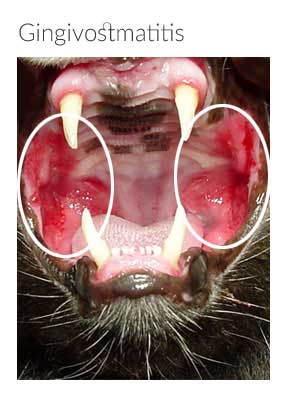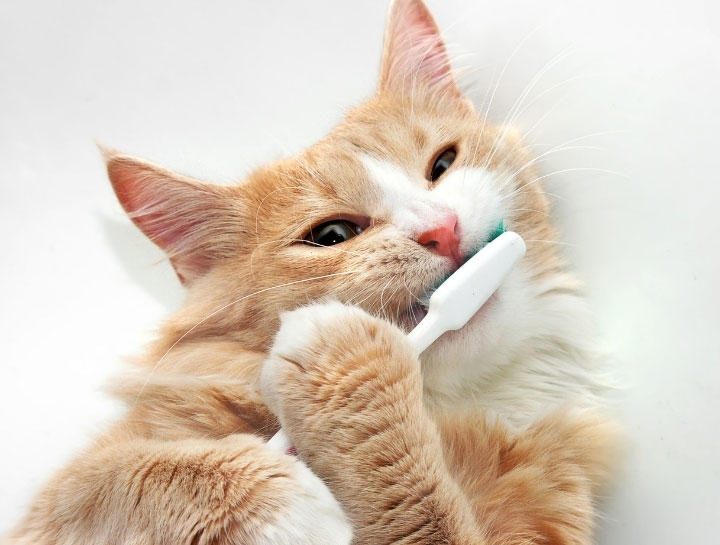Cat Dental Care
Preventative dental care in cats
Feline dental care is perhaps the most overlooked and under-treated area in small animal medicine. Cats, while affected by many of the same dental problems as small dogs, are also affected by species-specific syndromes such as tooth resorption and gingivostamatitis.
State-of-the-art Pet Dental Care
Through high-speed fiber optic and ultrasonic technology, our dental machines lessen the procedure and anesthesia time while offering precision cleanings with less trauma to the gums and oral cavity. With a portable, intra-oral dental x-ray machine we are able to easily image the entire tooth and surrounding bone to accurately and quickly diagnose periodontal and bony diseases of the mouth.
Tooth Resorption
 Tooth Resorption (TR), also known as cavities, neck lesions, external or internal root resorptions, or cervical line erosions, affects over 50% of cats three years old or older. This most commonly happens where the gum meets the tooth surface. Molars are most commonly affected; however, tooth resorptions can be found on any tooth. The reason for the resorption is unknown, but theories supporting an autoimmune response have been proposed. Cats affected with tooth resorption may show:
Tooth Resorption (TR), also known as cavities, neck lesions, external or internal root resorptions, or cervical line erosions, affects over 50% of cats three years old or older. This most commonly happens where the gum meets the tooth surface. Molars are most commonly affected; however, tooth resorptions can be found on any tooth. The reason for the resorption is unknown, but theories supporting an autoimmune response have been proposed. Cats affected with tooth resorption may show:
- Excessive salivation
- Bleeding in the mouth
- Difficulty eating
Tooth resorptions can be quite painful. The majority of affected cats do not show obvious clinical signs. Most times it is up to the clinician to diagnose the lesions upon oral examination. Diagnostic aids include a probe or cotton tipped applicator applied to the suspected resorption; when the probe touches the lesion, it causes pain and jaw spasms. Radiographs are helpful in making definitive diagnosis and treatment planning.
Gingivostmatitis
 Cats can also be affected by an inflammatory disease called Gingivostomatitis. The cause of this disease has not been determined but an immune-related cause is suspected. Signs in an affected cat include:
Cats can also be affected by an inflammatory disease called Gingivostomatitis. The cause of this disease has not been determined but an immune-related cause is suspected. Signs in an affected cat include:
- Difficulty swallowing
- Weight loss
- Excessive saliva
An oral examination can show many abnormalities. Radiographs often reveal moderate to severe periodontal disease with bone loss. Managing a case of gingivostomatitis can be challenging. Often, attempts at conservative therapy are ineffective. Extracting the cheek teeth usually resolves the syndrome in sixty percent of the cases. Other treatment options are available on a case by case situation.
Cancer
Cats are also affected by cancer in their mouths. But not all feline oral swellings are malignant. Cats can frequently be affected by reactions to foreign bodies, problems from dental disease, infections and other benign lumps. Biopsies are essential for diagnosis.
Stages of Dental Disease
During your routine annual exam, the doctor will look at your cat’s teeth and evaluate the dental grade.
- Grade 0: No sign of plaque or calculus
- Grade 1 Gingivitis: The margin of attached gum is inflamed and swollen. Plaque covers teeth.
- Grade 2 Early Periodontitis: Increased inflammation with subgingival plaque and calculus. No root exposure. This stage is reversible with adequate and prompt treatment.
- https://youtu.be/FKkz_q0f2LUGrade 3 Established Periodontitis: The gums are red and bleed easily. They have been permanently damaged by the calculus and infection.
- Grade 4 Advanced Periodontitis: Chronic infection is destroying the gums, teeth, and supporting bone. Bacteria are spreading through the body via the bloodstream, and may damage vital organ systems.
Signs of Dental Problems
- Red inflamed gums
- Loose teeth
- Bad breath
- Difficulty chewing
- Pain
- Discolored teeth
- In extreme cases, your cat will stop eating

